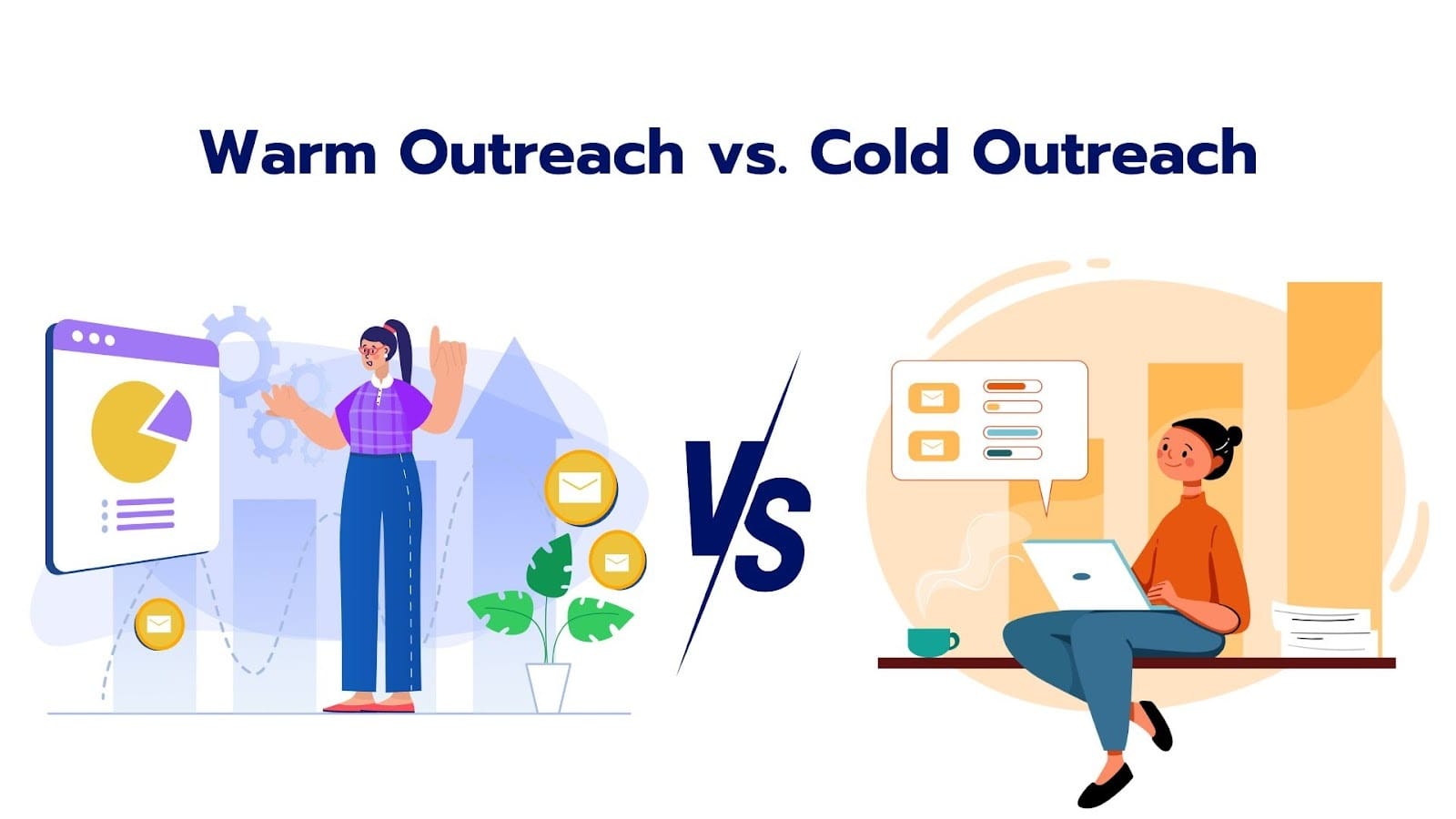Warm Outreach vs Cold Outreach: Sales Lead Types Differences
Get a detailed comparison of warm outreach vs cold outreach strategies to enhance your sales efforts and boost engagement effectively!

Understanding Cold Outreach
1. Definition and Purpose
2. Characteristics of Cold Outreach
3. Challenges and Opportunities
Understanding Warm Outreach
1. Definition and Importance
2. Key Characteristics of Warm Outreach
3. Personalization and Relationship Building
Core Differences Between Cold and Warm Outreach
1. Target Audience
2. Communication Style
3. Response and Engagement Levels
Advantages and Limitations of Cold Outreach
1. Mass Communication Capabilities
2. Cost-Effectiveness
3. Compliance and Risk Factors
Advantages and Limitations of Warm Outreach
1. Higher Engagement Rates
2. Reliance on Existing Relationships
3. Challenges in Scaling and Fresh Lead Attraction
Strategies for Effective Outreach
1. Blending Cold and Warm Outreach Approaches
2. Utilizing Personalization Tools
3. Implementing Follow-Up and Analytics
Building an Outreach Strategy
1. Identifying and Segmenting the Audience
2. Crafting Targeted Messages
3. Choosing Appropriate Outreach Tools
Conclusion
1. Summary of Key Differences and Applications
2. Importance of Both Approaches in Marketing
3. Final Recommendations for Outreach Strategy
Revised Outline
Introduction
What is Cold Outreach?
Limitations
Advantages
Here, we can pitch in Alisha
What is Warm Outreach?
Limitations
Advantages
Cold Outreach Vs Warm Outreach?
Comparison table (for quick view)
Detailed comparison
Strategies for Effective Outreach
Which is better for your business?
Conclusion
SERP SOURCES:
https://www.cognism.com/blog/warm-calling-vs-cold-calling
https://www.usergems.com/blog/cold-leads-vs-warm-leads-does-it-matter-when-sales-prospecting
https://www.breakcold.com/blog/cold-email-vs-warm-email
When it comes to outbound sales, one of the biggest decisions you’ll face is whether to go with warm outreach or cold outreach. Both approaches can be effective, but they work in different ways and require distinct strategies. The key is understanding when and how to use each method to get the best results.
Let’s start with some numbers to give you an idea of the difference. Research shows that 80% of sales require at least five follow-ups to close a deal, with warm leads being more likely to convert after fewer touchpoints. On the other hand, cold outreach can yield lower response rates, but it helps you reach new prospects and expand your network—especially when using tools like automated emails or cold calls.
In this article, we’ll break down the key differences between warm and cold outreach, how each approach works, and when to use them to maximize your sales efforts.
What is Cold Outreach?
Cold outreach is essentially reaching out to people who don’t know you or your business. It’s like knocking on a stranger’s door and introducing yourself without any prior connection. There’s no warm lead here—just a blank slate. This approach is all about generating new leads, creating awareness, and starting connections from scratch.
While it may seem daunting at first, cold outreach is a common and effective strategy for businesses looking to expand their network and bring in new prospects. It’s direct, and while it might take time to nurture these leads, it’s a valuable way to grow your customer base.
While cold outreach campaigns are commonly used in the early stages of a sales process, it's essential to understand their unique benefits and challenges.
That’s where Floworks.ai’ Alisha comes in. With Alisha, you can automate cold outreach with hyper-personalized messages that increase engagement and minimize the risks of negative responses.
Source: Link
Let’s now understand warm outreach.
What is Warm Outreach?
Warm outreach is all about reaching out to people who already know a little bit about your business. These are prospects who have previously shown interest in your products or services in some way—maybe they’ve visited your website, signed up for your newsletter, or engaged with your brand on social media.
Unlike cold outreach, where you're contacting people with no prior connection, warm outreach leverages the existing familiarity with your brand. This makes it easier to start a conversation, as the prospect isn’t hearing about you for the first time. They’ve already shown some level of interest, so the chances of getting a response are much higher.
Pros and Cons of Warm Outreach
So, how do these two strategies compare? Let’s break it down in detail to see how cold outreach stacks up against warm outreach.
Warm Outreach vs Cold Outreach: Detailed Comparison
Let’s start with a quick overview.
This comparison gives you a quick overview, but let's explore these points more deeply.
1. Audience Familiarity
Cold Outreach: When you're reaching out to prospects with no prior relationship or familiarity, it's like introducing yourself to a stranger. You’re casting a wide net, hoping to find those interested in your product or service.
Warm Outreach: This targets leads who have already interacted with your business in some way—like visiting your website, downloading content, or having a previous conversation. Since they know your brand, the outreach feels more natural and relevant.
2. Engagement Rate
Cold Outreach: Cold outreach generally sees lower engagement rates. Because the prospect doesn’t know you or your business, the likelihood of them responding positively is lower. Your message may not immediately resonate, leading to fewer responses or actions.
Warm Outreach: Warm outreach typically leads to higher engagement and response rates. Since the prospect is familiar with your brand or product, they’re more likely to open your message and take action. People tend to respond better when they’ve already interacted with the brand or shown interest in it.
3. Speed to Conversion
Cold Outreach: Cold outreach usually takes longer to convert leads into customers. Since these prospects haven’t interacted with your business yet, nurturing the relationship and building trust takes time. You may need several touchpoints to guide them through the sales funnel.
Warm Outreach: Warm outreach speeds up the conversion process. Warm leads are closer to making a decision since they’ve already engaged with your business in some form. As a result, you’ll often see faster conversion times, as these prospects are typically more open to moving forward.
4. Scalability
Cold Outreach: Highly scalable. You can reach a lot of people at once through automation, whether it’s via email or social media. It's a great way to expand your reach without too much effort.
Warm Outreach: Less scalable. Since it’s all about personalization and follow-ups, managing a growing pool of warm leads can get tricky. It’s harder to scale without losing that personal touch.
5. Customization
Cold Outreach: Cold outreach is usually less personalized. You'll often rely on generic templates or messages since you’re reaching out to prospects who haven’t interacted with your brand. While some customization is possible, it’s not as effective as when you have prior knowledge of the lead.
Warm Outreach: Warm outreach is highly customizable. You can tailor your messaging based on the prospect's previous interactions, such as content they've downloaded or a webinar they attended. This makes your outreach more relevant and personal, significantly improving the chances of engagement.
6. Risk of Negative Feedback
Cold Outreach: There's a higher risk of negative feedback. People may perceive your outreach as intrusive, especially if they don’t know your brand, and your emails might get marked as spam.
Warm Outreach: The risk is lower. Since these prospects have already interacted with you, your outreach is more likely to be seen as a continuation of the relationship rather than an unwelcome solicitation.
7. Cost-Effectiveness
Cold Outreach: Cold outreach is generally more cost-effective in terms of reaching a large number of prospects. Automated systems can send emails or social media messages at scale without additional resources. However, its cost-effectiveness is somewhat reduced by the lower conversion rates and engagement.
Warm Outreach: Warm outreach requires more time and resources to maintain personalized communication and follow-up. While the conversion rate is typically higher, the cost per lead is often more expensive due to the time invested in relationship-building and personalization.
Now that you understand the differences between cold and warm outreach, let’s explore some effective strategies to maximize your success with both methods.
Strategies for Effective Outreach
Whether you’re focusing on cold outreach or warm outreach, using the right strategies can make all the difference in your results. Here are a few strategies that can improve your outreach efforts:
- Segment Your Audience:
Whether you’re doing cold or warm outreach, the key to success is understanding your audience. Segmenting your prospects based on factors like industry, job role, or pain points allows you to create targeted messages that are more likely to grab attention and resonate with the recipient. Tailoring your approach makes sure you're speaking directly to their needs, not just sending out generic blasts.
- Personalization:
Personalization is especially important in warm outreach. Since these prospects have already interacted with your business, referencing those past interactions can create a more meaningful conversation. Mentioning something specific they did, like downloading a guide or attending a webinar, shows you’ve paid attention and understand their challenges.
- Use Omni-channel Outreach:
Don’t rely just on one channel like email. To truly engage prospects, reach them through multiple touchpoints. For example, tools like Floworks.ai’s Alisha make it easy to automate outreach across LinkedIn and email.
Alisha even sends LinkedIn invites to leads who open your emails, keeping the conversation going across platforms. This not only expands your reach but also increases your chances of engagement by meeting prospects where they are.
- Automate Where Possible:
Let’s face it, doing everything manually can be time-consuming. Automation tools can handle much of the repetitive work, letting you scale your efforts without sacrificing consistency or personalization. You can automate follow-ups, email sequences, and even social media outreach while keeping your messages tailored to the individual.
- Focus on Timing:
Timing plays a huge role in the success of your outreach. Whether it’s following up within an hour of engagement or knowing when to send your emails for maximum open rates, being mindful of timing can make a big difference. Pay attention to when your leads are most likely to engage and adjust your strategy accordingly.
Now, let’s know which outreach will be best for you.
Which is Better for Your Business?
The answer depends on your business goals, your resources, and the stage of your sales funnel.
- Cold Outreach: If you want to expand your reach and generate many new leads quickly, cold outreach can be highly effective. It's great for building brand awareness and entering new markets.
- Warm Outreach: On the other hand, if you’ve already built a customer base or have a solid CRM with qualified leads, warm outreach is the better choice. It drives higher engagement and conversions, leading to more immediate sales results.
Conclusion
In reality, a combination of both cold and warm outreach tends to work best. Start with cold outreach to cast a wide net and expand your lead pool, then use warm outreach to nurture those leads with more personalized communication as they move through the sales funnel.
There’s no perfect solution when it comes to choosing between cold or warm outreach—each method has its strengths and challenges. The key is knowing when and how to use them to your advantage.
The good news is that with the right strategy—and the right tools like Floworks.ai’s Alisha—you can make both approaches more effective. Floworks.ai is a powerful sales automation platform that streamlines lead generation and sales outreach. Automating workflows and utilizing Alisha's AI-driven communication tool, businesses optimize their sales processes and drive better results.
Ready to streamline your outreach and boost your conversions? Let Alisha do the heavy lifting for you. Get started with Floworks.ai today!
FAQs
What are examples of warm outreach?
Examples of warm outreach include reaching out to leads who have previously interacted with your content, such as website visitors, event attendees, or people who’ve engaged with your email campaigns. It’s also effective when following up on past interactions or referrals from existing clients. Warm outreach feels personal, leveraging prior connections to initiate meaningful conversations.
Is cold outreach sales or marketing?
Cold outreach is typically part of sales efforts, where a salesperson contacts potential leads who haven’t interacted with your brand before. It often involves tactics like cold calls, unsolicited emails, or social media messaging. While it may start as a marketing initiative, its core focus is generating sales opportunities.
What is the difference between warm and cold leads?
Warm leads are individuals or organizations that have shown interest in your product or service, such as downloading a white paper or attending a webinar. Cold leads, on the other hand, have no prior engagement and may not yet be aware of your offering. The key difference lies in the warmth of the connection and the likelihood of conversion.
Is outreach a CRM system?
Outreach is not a CRM system but often integrates with CRM platforms to enhance communication strategies. It refers to contacting leads through email, calls, or social media. A CRM system helps manage and track these interactions, while outreach focuses on the initial engagement.


